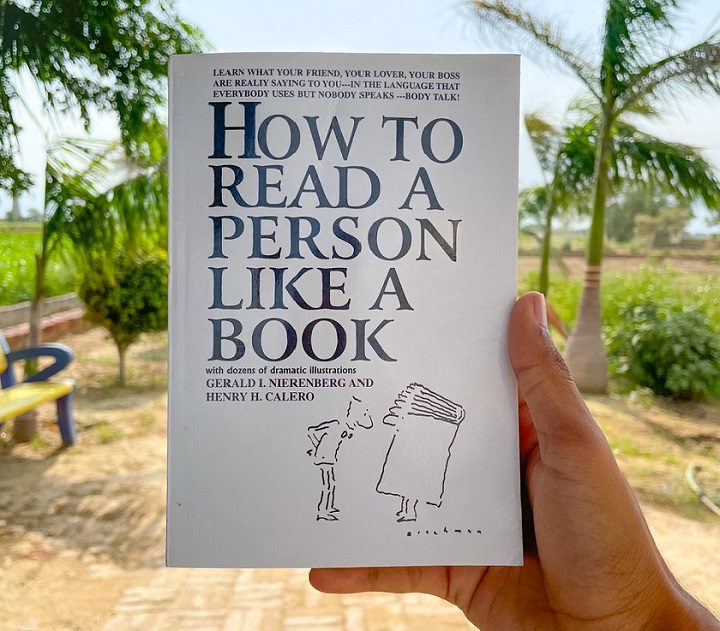Do you know that 70 to 93 percent of all communication is nonverbal? What if you had a book or guide helping you to gain deeper insights into this hidden human mysterious side or body talk?
Gerard Nierenberg’s “How to Read a Person Like a Book” is an absolute must-read book. This comprehensive guide offers you practical lessons on interpreting nonverbal cues, making it an invaluable resource for anyone eager to enhance their communication skills and build stronger connections.
In this post, learn 10 best lessons from the book that you can use daily. Understanding nonverbal cues is a valuable skill with broad-reaching benefits. It enhances communication by providing insights into people’s thoughts, emotions, and intentions, fostering stronger connections and reducing misunderstandings.
Interpreting Nonverbal Cues and Body Language
Dive into the world of nonverbal communication and discover the importance of paying attention to subtle gestures, facial expressions, and posture.
Imagine you’re in a meeting, and a colleague’s crossed arms and subtle fidgeting reveal discomfort as a certain topic arises. Recognizing these nonverbal cues allows you to understand their unease, prompting you to adjust your approach and create a more comfortable environment.
By doing so, you’ll gain a unique ability to understand people’s emotional states, intentions, and attitudes, paving the way for more meaningful and effective communication.
Understanding the Power of Eye Contact and Gaze
Imagine being able to decode the significance of eye contact in every interaction. Nierenberg shows you how to recognize the role of eye contact in conveying trust, sincerity, and engagement.
Picture yourself in a job interview where the interviewer’s consistent eye contact conveys trust and sincerity. You instantly feel a connection, realizing the impact of eye contact on building trust and establishing rapport in professional interactions.
By understanding people’s eye movements, you’ll establish connections and rapport that go beyond words.
Analyzing Facial Expressions and Microexpressions
Picture yourself decoding the emotions, moods, and hidden sentiments behind facial expressions and microexpressions.
Consider a situation where a friend verbally expresses happiness, but a microexpression of sadness flickers across their face. The book teaches you to catch these subtle cues, offering insights into concealed emotions and fostering more genuine connections.
Nierenberg guides you through the art of observing subtle changes in facial muscles, empowering you to respond with empathy and effective communication strategies.
Decoding Verbal and Nonverbal Incongruence
Equip yourself with the skills to identify inconsistencies between what people say and how they express themselves nonverbally.
Envision a coworker enthusiastically discussing a project while displaying closed-off body language. By recognizing this incongruence, you can address potential issues or misunderstandings, leading to more transparent and authentic communication.
By doing so, you’ll be able to address potential signs of dishonesty, discomfort, or emotional conflict with clarity and empathy, fostering authentic and transparent communication.
Recognizing Posture and Body Movement Patterns
Envision understanding the significance of posture and body movement patterns in gauging confidence, comfort, and engagement levels.
Imagine a conversation where a friend’s relaxed posture and open gestures indicate genuine engagement. By observing these body movement patterns, you gain valuable insights into their comfort level and create a more inclusive and respectful interaction.
By paying attention to these cues, you’ll adjust your communication style to create inclusive and respectful environments that encourage open communication and mutual respect.
Developing Empathy and Emotional Intelligence
Take the journey towards cultivating empathy and emotional intelligence. Nierenberg encourages you to deepen your understanding of others’ emotions, perspectives, and experiences.
Picture a scenario where a family member shares a personal challenge, and your empathetic response fosters a deeper connection. The book guides you in cultivating empathy and emotional intelligence, enhancing your ability to understand and support others.
Through practicing empathy, active listening, and effective communication, you’ll foster a compassionate environment that nurtures meaningful connections.
The Role of Cultural Sensitivity and Contextual Awareness
Imagine being able to navigate diverse cultures, religions, and gender contexts seamlessly. Nierenberg emphasizes the importance of being culturally sensitive, neutral, and aware of contextual factors.
Think about a cross-cultural exchange where being mindful of cultural nuances transforms the conversation. The book emphasizes adapting your communication style to create an inclusive environment, fostering effective cross-cultural understanding.
You’ll adapt your approach, language, and communication strategies to foster an inclusive and respectful environment.
Applying Active Listening and Open-Ended Questions
Picture yourself engaging in meaningful conversations through active listening and open-ended questions.
Picture a conversation with your spouse where your focus is on listening to truly understand, rather than simply responding. By actively engaging with the speaker’s words and using open-ended questions, you create a space for deeper comprehension. This approach fosters meaningful connections based on genuine interest, allowing for a constructive exchange of ideas and perspectives rather than a mere reactive response.
By incorporating these practices, you’ll build stronger connections based on genuine interest and collaborative problem-solving.
Cultivating Trust and Rapport through Mirroring and Matching Techniques
Learn the art of using mirroring and matching techniques to cultivate trust and rapport.
Envision a scenario where your senior or manager is up for a promotion. By subtly mirroring their communication style, body language, and gestures during discussions and presentations, you establish a sense of familiarity and understanding. This can potentially even secure you a raise.
By mirroring people’s body language and communication styles, you’ll create a comfortable and mutually supportive environment that encourages open communication and positive engagement.
Promoting Effective Conflict Resolution and Relationship Building
Imagine prioritizing constructive dialogue, empathy, and mutual respect in resolving conflicts.
Consider a situation where addressing a conflict with empathy and open communication strengthens teamwork relationships. The book’s principles guide you in resolving conflicts constructively, fostering a positive interpersonal dynamic and shared success.
Nierenberg guides you toward effective problem-solving that fosters mutual trust, understanding, and positive interpersonal dynamics in both personal and professional relationships.
Conclusion
In “How to Read a Person Like a Book,” Nierenberg provides you with practical insights that go beyond words. Anyone from business professionals navigating negotiations, to individuals seeking improved personal relationships or job seekers can benefit. Recognizing nonverbal cues allows for more effective and empathetic interactions, making it a crucial skill for anyone looking to enhance their communication abilities in various personal and professional settings. Grab your copy now and embark on a journey towards more meaningful and fulfilling interactions!



